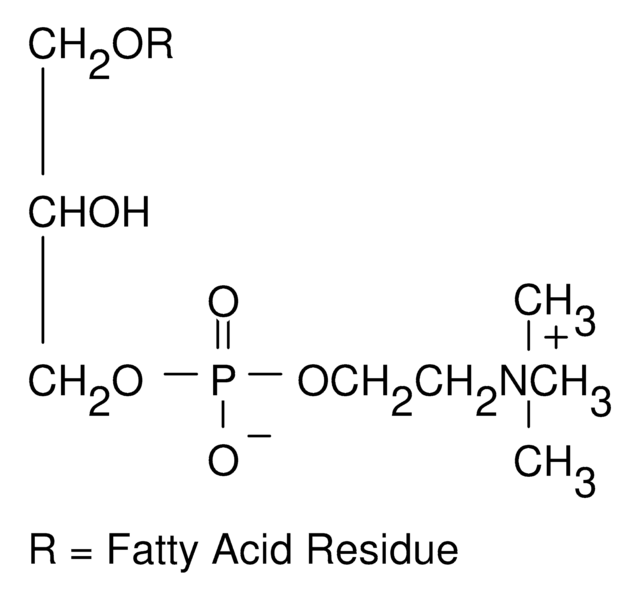Kluczowe dokumenty
857130C
Avanti
18:1 Lyso PA
1-oleoyl-2-hydroxy-sn-glycero-3-phosphate (sodium salt), chloroform
Synonim(y):
oleoyl lysophosphatidic acid; 1-(9Z-octadecenoyl)-sn-glycero-3-phosphate (sodium salt); PA(18:1(9Z)/0:0); 18:1 LPA; o-LPA; 110681
About This Item
Polecane produkty
Próba
>99% (LPA; may contain up to 10% of the 2-LPA isomer, TLC)
Formularz
liquid
opakowanie
pkg of 1 × 2.5 mL (857130C-25mg)
pkg of 2 × 4 mL (857130C-200mg)
producent / nazwa handlowa
Avanti Research™ - A Croda Brand 857130C
stężenie
10 mg/mL (857130C-25mg)
25 mg/mL (857130C-200mg)
typ lipidu
cardiolipins
phospholipids
Warunki transportu
dry ice
temp. przechowywania
−20°C
InChI
1S/C21H41O7P.Na/c1-2-3-4-5-6-7-8-9-10-11-12-13-14-15-16-17-21(23)27-18-20(22)19-28-29(24,25)26;/h9-10,20,22H,2-8,11-19H2,1H3,(H2,24,25,26);/q;+1/p-1/b10-9-;/t20-;/m1./s1
Klucz InChI
XGRLSUFHELJJAB-JGSYTFBMSA-M
Opis ogólny
Zastosowanie
- for liposome preparations
- to study its apoptotic effect in HeLa cells
- to determine the extraction recovery of LPA at neutral pH and acidic pH by chromatography
- to use as a LPA agonist supplement in oocytes maturation medium to study its effects during in vitro maturation of bovine cumulus–oocyte complexes
Działania biochem./fizjol.
Opakowanie
Informacje prawne
Hasło ostrzegawcze
Danger
Zwroty wskazujące rodzaj zagrożenia
Zwroty wskazujące środki ostrożności
Klasyfikacja zagrożeń
Acute Tox. 3 Inhalation - Acute Tox. 4 Oral - Aquatic Chronic 3 - Carc. 2 - Eye Irrit. 2 - Repr. 2 - Skin Irrit. 2 - STOT RE 1 - STOT SE 3
Organy docelowe
Central nervous system, Liver,Kidney
Kod klasy składowania
6.1D - Non-combustible acute toxic Cat.3 / toxic hazardous materials or hazardous materials causing chronic effects
Klasa zagrożenia wodnego (WGK)
WGK 3
Temperatura zapłonu (°F)
does not flash
Temperatura zapłonu (°C)
does not flash
Wybierz jedną z najnowszych wersji:
Certyfikaty analizy (CoA)
Przepraszamy, ale COA dla tego produktu nie jest aktualnie dostępny online.
Proszę o kontakt, jeśli potrzebna jest pomoc Obsługa Klienta
Masz już ten produkt?
Dokumenty związane z niedawno zakupionymi produktami zostały zamieszczone w Bibliotece dokumentów.
Klienci oglądali również te produkty
Nasz zespół naukowców ma doświadczenie we wszystkich obszarach badań, w tym w naukach przyrodniczych, materiałoznawstwie, syntezie chemicznej, chromatografii, analityce i wielu innych dziedzinach.
Skontaktuj się z zespołem ds. pomocy technicznej















